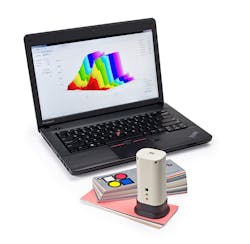SPECTROPHOTOMETRY: ChromaID scanner challenges traditional spectrophotometry
Traditional spectrophotometers measure reflected or transmitted light from a sample as a function of wavelength, typically by sending broadband light through a prism or diffraction grating and measuring the light with a linear CCD array. But a new lower cost and potentially less bulky method from Visualant (Seattle, WA) eliminates the need for delicate optical components and expensive detectors by using a “virtual” light-emitting diode (LED) source and inexpensive photodiode detectors.1 The technology could be used in a myriad of applications now being addressed by handheld spectrometers and emerging chip-based spectroscopy designs.
Spectral pattern matching
The LED source consists of any number of individual LEDs—from the ultraviolet (UV) through the visible and even into the near-infrared (near-IR) spectrum—incorporated into an emitter module that paints a structured pattern of light onto the sample being measured. The source is described as virtual because the current supplied to the LEDs is varied through a sequence of steps to vary the frequency of the light produced by the emitter.
The virtual LED technique allows Visualant to cover a wider light spectrum using a limited number of LEDs. For example, one prototype source incorporates 34 emitters that are fired through 25 current steps in a sequence that is repeated four times; in effect, a single less-than-one-second scan paints 34 × 25 × 4 = 3400 flashes of light onto the sample. The Rayleigh reflections from these flashes are measured by photodetectors and the data is captured as a two-dimensional profile called a ChromaID.
This ChromaID is plotted on a chart showing the intensity of the reflected light at each wavelength and spectral pattern matching (SPM) is used to compare the pattern to a database of patterns from known substances (see figure). Visualant holds patents describing how these database comparisons are made.
Field analysis
Operating between 350 and 1450 nm, the ChromaID scanner is handheld and easily operated either in a laboratory setting or in the field. Recent testing on plastic sample bags containing a variety of similar-looking white powders demonstrated that the SPM ChromaID method was able to distinguish between flea powder, household cleaner, ground Tums, Splenda, baby powder, and cornstarch, to name a few.
The Visualant ChromaID technology was developed by University of Washington (Seattle, WA) professors Tom Furness and Brian Showengerdt over a seven-year period at Tom’s skunkworks, the “RATLab.” Visualant has partnered with Sumitomo Precision Products (Tokyo, Japan) to manufacture the initial scan head and further reduce the technology to a reliable and cost-effective form for flat-surface applications.
“Over the last six months we have transferred the technology into a form we can manufacture,” says Richard Mander, vice president of product management and technology at Visualant. “We are excited to now be designing products that customers can use.”
For more information, see http://youtu.be/ddjcafJ-J30.
REFERENCE
1. R. Mander, “Introducing Visualant Spectral Pattern Matching Technology,” white paper; see http://bit.ly/STmccA (October 2012).
About the Author

Gail Overton
Senior Editor (2004-2020)
Gail has more than 30 years of engineering, marketing, product management, and editorial experience in the photonics and optical communications industry. Before joining the staff at Laser Focus World in 2004, she held many product management and product marketing roles in the fiber-optics industry, most notably at Hughes (El Segundo, CA), GTE Labs (Waltham, MA), Corning (Corning, NY), Photon Kinetics (Beaverton, OR), and Newport Corporation (Irvine, CA). During her marketing career, Gail published articles in WDM Solutions and Sensors magazine and traveled internationally to conduct product and sales training. Gail received her BS degree in physics, with an emphasis in optics, from San Diego State University in San Diego, CA in May 1986.
